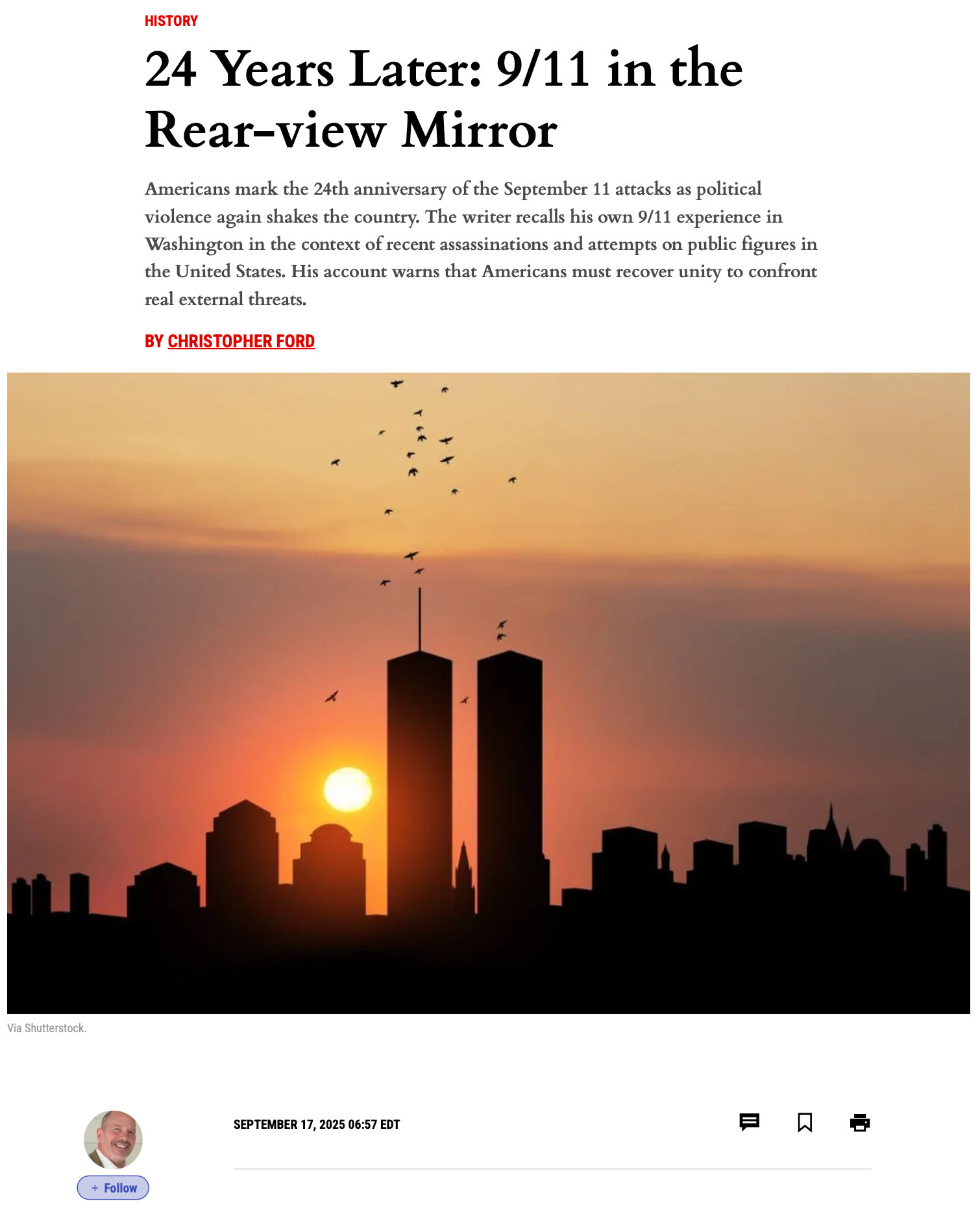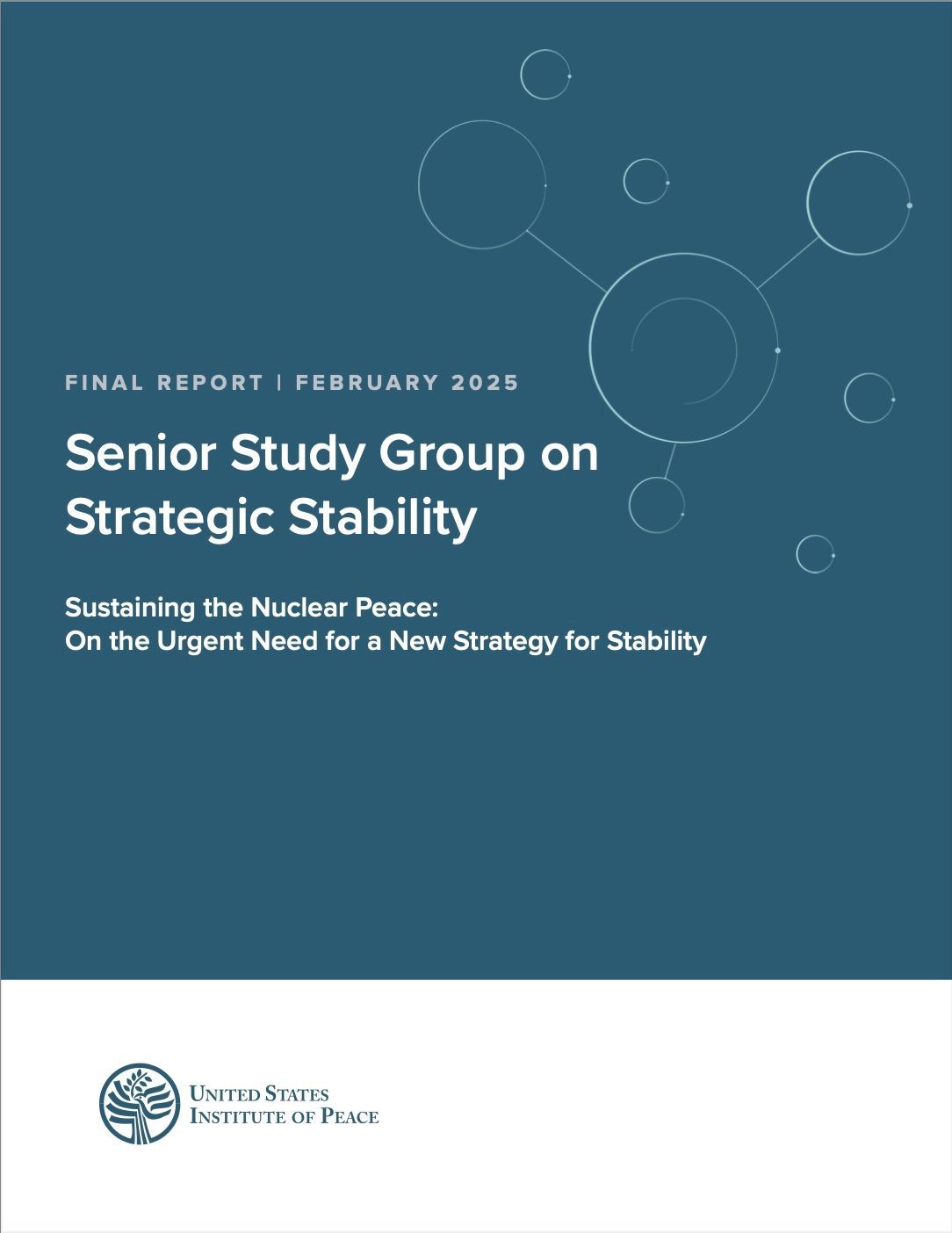USIP's Clarion Call on Strategic Stability
Below is the prepared text upon which Dr. Ford based his remarks at an event at Hudson Institute on October 2, 2025, on the U.S. Institute of Peace Senior Study Group on Strategic Stability’s recent report on “Sustaining the Nuclear Peace.”
At 36 pages of single-spaced print, our report on “Sustaining the Nuclear Peace” isn’t exactly short. But it’s pretty hard-hitting, both in its intellectual critique of prior U.S. approaches to nuclear deterrence and strategic stability policy and in its call for the United States to adopt a much more robust new approach as quickly as possible.
I’ll offer you my personal views about it here today, of course, and those views will only be my own. Nevertheless, the report’s actual analysis and findings were both bipartisan and unanimous, so they clearly represent the view of all of us.
New Definition of Strategic Stability
To begin with, I think we make an important contribution not only in terms of specific policy recommendations – which I’ll come to in a moment – but also to the theory that underlies U.S. approaches to nuclear deterrence. In particular, the report articulates a new, “updated” conception of strategic stability:
“Strategic stability is a condition in which the political relations and military balance between states that pose an existential threat to each other are such that they perceive neither a compelling need nor a viable opportunity to advance their interests at the expense of the vital interests of the other through the use of military force, and especially nuclear weapons.”
This is a broader definition than many experts have hitherto used in the nuclear weapons policy arena, and I hope it will be influential, because I think the policy community has created problems for itself by thinking of strategic stability for so long through the lens of only one of its facets: that of nuclear first-strike stability. That’s obviously important, but in the real world, there’s more to keeping the global security environment from decaying into full-scale war – including nuclear war– than just that angle. And our expanded definition reflects that.
After all, the definition of “strategic stability” has long been contested. Back in 2013, for instance, I wrote a chapter for a book co-edited by Bridge Colby and Michael Gerson on strategic stability, and we probably had as many different definitions of it in that volume as there were authors. So I’d offer our group’s definition, now, as a valuable conceptual advance.
Strong Critique of Obsolete Past Approaches
Now, I’m certainly a national security policy wonk and a professor at Missouri State University’s School of Defense and Strategic Studies, so I guess it’s not that surprising that I’m pretty proud of our contribution to defining strategic stability.
That said, I think the greatest strength of our unanimous and bipartisan report lies in its conclusions – not just about what to do in the months and years ahead, but also about the grave inadequacy of prior U.S. policy. We don’t just warn of growing threats: we explicitly call out the bankruptcy of prior approaches to strategic stability.
In particular, we don’t just add our voice to the rising chorus pointing out that the current U.S. strategic modernization Program of Record (POR) is insufficient: we add in the broader point that a whole generation of American strategy and strategic thinking has become obsolescent.
The report makes clear, for instance, that the traditional U.S. prioritization of direct diplomatic engagement and cooperative measures with our strategic adversaries is no longer viable as a route to strategic stability. Presidents Putin and Xi show little sign of actually wanting strategic stability, and indeed seem to view instability as essential to their geopolitical ambitions.
Accordingly, our longstanding approach has failed, and is actually now dangerous. “The US strategy for stability since the Cold War,” our report warns, is no longer “applicable to the emerging security environment.” Among other things,
“U.S. attempts to reduce the role of nuclear weapons in its security strategy have been ignored and, in fact, exploited. Washington’s calls for substantive, sustained, and high-level dialogue on strategic stability with both Moscow and Beijing have gone largely unheeded.”
Our traditional diplomatic strategy, therefore, has “failed to achieve its intended purposes,” and in failing so far to reorient its approaches to grave new threats, “we can see that the United States has been negligent in preserving and adapting a strong nuclear deterrent.”
As clearly as we can state things, therefore, our report stands as a repudiation of those who think that past approaches can still be made to work:
“There is no going back to the legacy approach. The effort to cooperate with Russia and China to identify and safeguard shared interests in strategic stability has come to naught—a situation that cannot be expected to change soon.”
That doesn’t necessarily mean that we should give up all hope of cooperation in the future, but our diplomats must “keep expectations appropriately low and prepare for failure.”
The main lesson from our unanimous and bipartisan report, I would say, is that it’s time to abandon the timid moralism and optimistic naivete of a conventional wisdom in strategic thinking that developed in a global security environment quite unlike the one we now face. It’s time, now, to be a lot less timid. “Leadership by example” has failed, and we now need to “rethink unilateral restraint.” Moscow and Beijing are already racing in a new arms race, and it would be madness for us to just stand back and watch. Instead, “the United States must go forward to a new approach.”
In our report, we do place great emphasis upon cooperative action, but we place it on cooperative action with our allies – who need themselves to do more in the common defense, and with whom we need to work closely to confront our shared adversaries with the insuperable strategic and theater-level nuclear and conventional dilemmas that they will need to face in order to be deterred.
This point about allies is one that can hardly be said enough in the current political climate in America, where it seems like the mental universe for our national defense planning is today shrinking back into a stale and antique 1890s hemispherism: there is no serious and sustainable approach to U.S. security that does not involve working closely with our allies in Europe and East Asia.
First and foremost, however, our new approach requires robust and resolute American action, because preserving deterrence and meeting the needs of strategic stability relies on our strength and resolve vis-à-vis our adversaries more than upon anything else.
“…[T]he United States must secure its interests in strategic stability in the absence of cooperation with Russia and China—and in the face of their cooperation with each other to threaten the United States and its allies.”
So what does this mean in practice? Most of all, our report says, we cannot get by merely with “a deterrence posture sized, scaled, and funded to meet only the requirements of a benign unipolar era now past. The time for such wishful thinking is over.” We cannot preserve the nuclear peace with a nuclear force posture that represents a diminished and shrunken “Mini-Me” version of one conceptualized two generations ago.
We agree with the Strategic Posture Review Commission’s 2023 conclusion that our current strategic modernization program of record is necessary but insufficient, but we take things a step further by calling for the United States to reverse nearly 60 years of force posture creep and begin to get back into the business of expanding our nuclear arsenal once again. Our report draws attention to the “likely requirement for a larger deployed strategic and theater nuclear force to address the two nuclear peer threat environment in the mid-to-late 2030s,” and urges we get moving to meet that requirement.
As the report pointedly observes, neither our strategic nuclear deterrent nor our “extended” nuclear deterrent are today fit for purpose, and they’re steadily losing ground in comparison to growing threats. In response, we need to expand National Nuclear Security Administration capacities to “meet the requirements of fielding and supporting larger deployed strategic and theater nuclear forces.” (In this period of mass federal layoffs and demoralizing chaos within the U.S. national security workforce, I should add, this includes recapitalizing both our “institutional and human capital assets.”)
We also need to begin uploading warheads to our strategic systems when the restraints of the New START agreement lapse, the report notes. And we need to accelerate procurement of the Submarine-Launched Cruise Missile-Nuclear (SLCM-N), build more and better “deep precision strike non-nuclear systems,” improve homeland defenses against all varieties of missile, and develop “game-changing directed-energy defenses against regional missile threats.”
The Need for a Truly National Effort
I hope our report’s forthright call for forward-leaning, concrete steps to arrest the rot in our deterrent capability and redress the obsolescence of longstanding approaches to strategic stability will serve as a clarion call to the rest of the policy community. In concluding, however, I also want to emphasize that this is not just a problem that can be fixed by national security policy wonks like us.
The report makes a strong call for our leaders to engage directly with the American people, and with Congress, on these matters. Meeting the challenges described in our report and securing the nuclear peace over the next generation will not be easy, quick, or inexpensive. To succeed, this great project requires collective buy-in from stakeholders across our society and from the citizenry as a whole at a time in which there has hitherto been relatively little public engagement on these topics. Accordingly, the time to clearly articulate these stark needs and build support for doing what America’s future security requires is now.
—Christopher Ford







